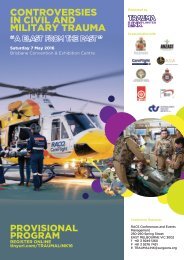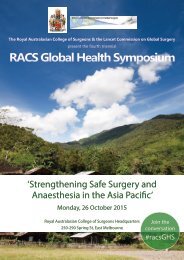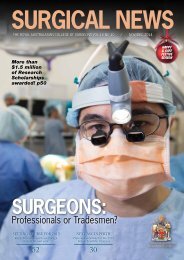You also want an ePaper? Increase the reach of your titles
YUMPU automatically turns print PDFs into web optimized ePapers that Google loves.
POST-<br />
OP<br />
SNAPPING HISTORY<br />
Fellow John Henderson has had a long enthusiasm<br />
for the photographic medium<br />
Victorian General Surgeon John Henderson developed<br />
his interest in photography as a schoolboy and has<br />
given his photographic skills and services to the<br />
College throughout his surgical career. As a young surgeon,<br />
he began taking his camera to Provincial Surgeons of<br />
Australia (PSA) meetings and as word of his skills spread<br />
through the profession he was later asked to photograph<br />
College meetings, orations and award ceremonies. These<br />
requests have since resulted in an archival treasure trove of<br />
thousands of images of Fellows from every major College<br />
meeting held in the past two decades. Now retired, Mr<br />
Henderson talks to Surgical News about the pleasure he<br />
has taken in creating a rich visual history for the benefit of<br />
current and future Fellows.<br />
What inspired you to take up photography?<br />
My interest in photography was originally fostered by my<br />
mother Mrs Mary Henderson who, for as long as I can<br />
remember, used to take 3.5 x 2.5 inch black and white photos<br />
of family events, from time to time, with her Kodak (620<br />
film) Box Brownie camera. In 1947, my parents came back to<br />
Victoria to live in Geelong and in August 1948 I was presented<br />
with a Box Brownie camera for my 16th birthday, just before<br />
my last term of school at St Ignatius College, Riverview,<br />
in Sydney. I was still taking black and white photographs<br />
with that camera during my six years in Newman College,<br />
Melbourne University, up until the time of my graduation at<br />
the end of 1955.<br />
What cameras did you use as a budding photographer?<br />
After I graduated, I started taking Kodachrome colour<br />
slides (reversal film) with a Zeiss Ikon Contaflex camera at St<br />
Vincent’s Hospital in Melbourne in 1956, the Geelong hospital<br />
in 1957, the Royal Women’s Hospital in 1958 and the Royal<br />
Children’s Hospital in 1959. I was still taking Kodachrome<br />
colour slides as a surgical registrar at the Alfred Hospital in<br />
1966 and back again at St Vincent’s Hospital in 1967. After<br />
Pam and I were married in January 1970, we went to London<br />
where I stated using Kodachrome colour negative film for<br />
colour prints. It was during those three years living in London<br />
that I obtained my English and Australasian Fellowships in<br />
1972 and my Edinburgh Fellowship in 1973.<br />
When did you first combine this artistic interest with<br />
your life as a surgeon?<br />
In surgical practice as an Assistant General Surgeon at<br />
the Geelong Hospital since July 1973, I attended several<br />
RACS General Scientific Meetings (GSMs) and by that<br />
time I was using a Nikon film camera, F-801s. When I first<br />
came back to the Geelong Hospital my very first mentor,<br />
Geoff Royal insisted that I attend PSA meetings. The first<br />
PSA meeting I attended was at Traralgon in 1981 where I<br />
took photos of family and friends and the venue. The most<br />
enigmatic photograph that I took at that meeting, however,<br />
was of a bird’s nest in the engine compartment of our PA32<br />
Piper Lance aeroplane, out at the Latrobe Valley Airport.<br />
Fortunately, someone at the airport had attached a big<br />
A4 note warning us about the nest inside the engine! My<br />
departure back to Geelong with Pam and our four children<br />
had to be delayed for an hour or two while we cleaned all of<br />
the straw and grass of the nest out of the engine!<br />
How did your role as informal RACS photographer<br />
develop?<br />
During the 1980s, Pam and I took more and more<br />
photographs at the PSA meetings each year which were<br />
included in the PSA “Proceedings Book” which mainly<br />
comprised summaries of all the papers presented at the<br />
meeting held the previous year. Consequently, when people<br />
arrived for the PSA each year, these Proceedings Books would<br />
be eagerly scrutinised to see the colour photos of the meeting<br />
from the previous year. The annual scientific meeting of the<br />
College, in Canberra, in 1992 was the last time this meeting<br />
was called the GSM. The College meeting in Adelaide in 1993<br />
was the first Annual Scientific Congress (ASC). In 1996, the<br />
ASC was in Melbourne and the convenor for that meeting was<br />
Mr Peter King, a long-time dedicated PSA aficionado as well<br />
as an experienced provincial surgeon, a College Councillor,<br />
an aviator (like at least a dozen other PSA regulars), a scholar<br />
and a gentleman. Peter King rang me and said: “You have<br />
to do the photos for the ASC just like you do them for the<br />
PSA!” Initially I protested believing that it would just not be<br />
possible to cover such a big meeting, the way we did every<br />
year for the PSA, but he insisted that I absolutely had to<br />
do it, so I did! The photos for the 1996 ASC were done, as<br />
requested by him, and I have been doing them for the College<br />
every year since.<br />
Were you solely responsible for all the images<br />
captured at these meetings?<br />
The College has always had professional photographers<br />
to photograph the official proceedings of the Convocation<br />
itself, the Syme Orator, the recipients of Medals and Awards<br />
and Honorary Fellowships and all the new Fellows getting<br />
their Diplomas. In later years, a number of very capable<br />
people became available to take more and more of the iconic<br />
photographs during the rest of each meeting while Pam and<br />
I continue to take more informal images.<br />
Can you list a highlight of your time as a photographer<br />
for the RACS?<br />
The year 2000 was the 75th anniversary year for the College<br />
and the ASC was held again in Melbourne. There, with the<br />
very considerable support of the College, we were able to set<br />
up an exhibition of colour prints mounted on large black<br />
card boards of previous GSMs and ASCs dating back several<br />
years which was greatly rewarding.<br />
How has photography changed since you first began<br />
providing your skills to the College?<br />
Back in the days of analogue photography, we would take<br />
our reels of Kodak Ektachrome, colour negative Kodachrome<br />
or Fujifilm along to the camera shops and they would<br />
produce sets of 10 x 15cm colour prints, as well as the cut-up<br />
strips of the colour negative film. Now, however, much of<br />
the photographic content of the ASC has been available as<br />
digital files to everybody with access to the Virtual Congress<br />
website. This facility makes it very easy for people to<br />
download and print their own copies of these photographs.<br />
Where are the photographs now stored and how can<br />
Fellows access them?<br />
Large format photographic albums of photos taken at the<br />
ASCs from Melbourne 1996 to Adelaide 2002 are now in<br />
the College Archives and since Brisbane 2003, appropriately<br />
labelled DVDs of all the ASCs and PSAs, as well as the<br />
Saturday Cowlishaw Symposium meetings are now in the<br />
College archives. I have also endeavoured to put together a<br />
video-photographic record of surgical conferences and events<br />
as well. These events include the “Begonia Prize” session at<br />
nearly every annual PSA meeting since 1981; some of the<br />
proceedings at SGMS and ASCs over the years including<br />
Surgical History papers; and, more recently, papers presented<br />
at the biennial Cowlishaw Symposiums.<br />
Some of these video-photographic records are in the form<br />
of fully edited (Avid Media Composer) DVDs and even Bluray<br />
discs but much of this video-photographic record still<br />
exists, currently, as unedited high definition BPAV and, more<br />
recently, AVCHD computer files on (in triplicate) external<br />
hard drives.<br />
What have you most enjoyed about taking on this role<br />
for the College throughout your surgical career?<br />
Pam and I feel very fortunate to have had the opportunity<br />
to take photographs at so many surgical conferences and<br />
events. But more importantly, this video-photographic<br />
documentation is not so much about the papers presented<br />
but rather the people who presented them! I believe that<br />
future generations of surgeons will want to be able to see<br />
both the photographic and the video-photographic record of<br />
our generation.<br />
With Karen Murphy<br />
36 <strong>SURGICAL</strong> <strong>NEWS</strong> APRIL 2016 <strong>SURGICAL</strong> <strong>NEWS</strong> APRIL 2016 37






